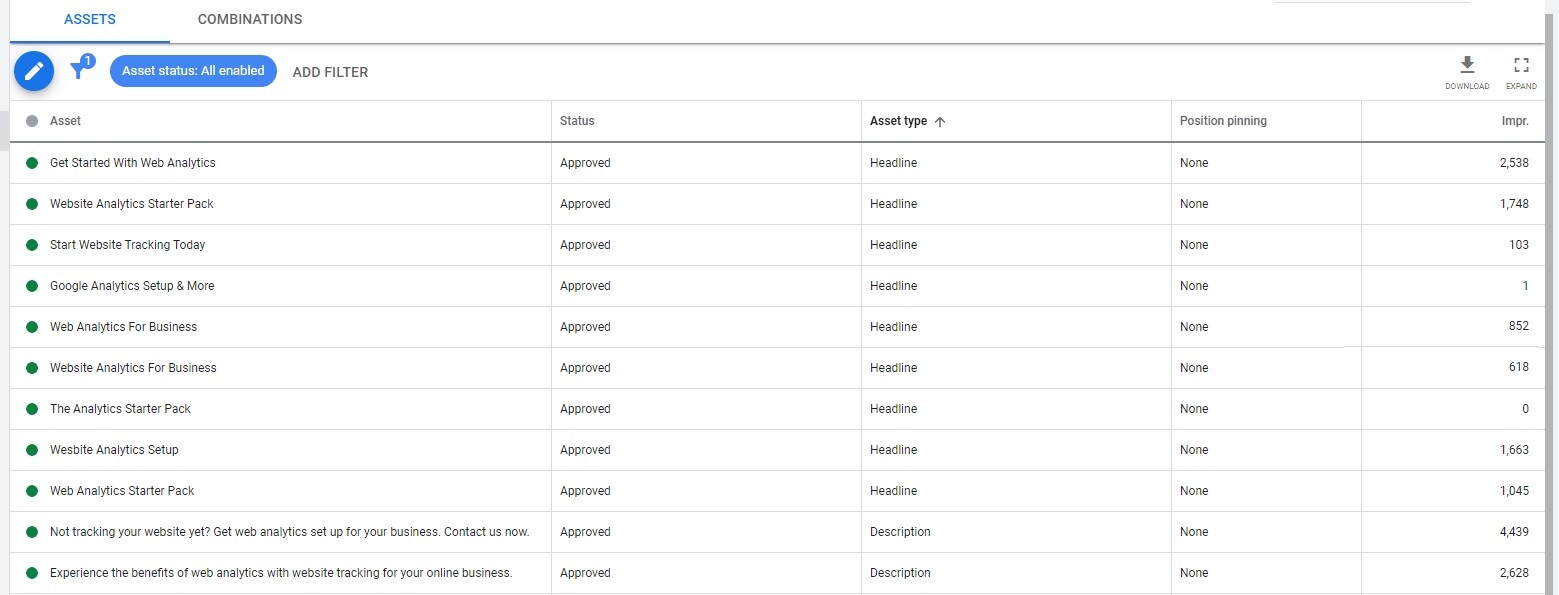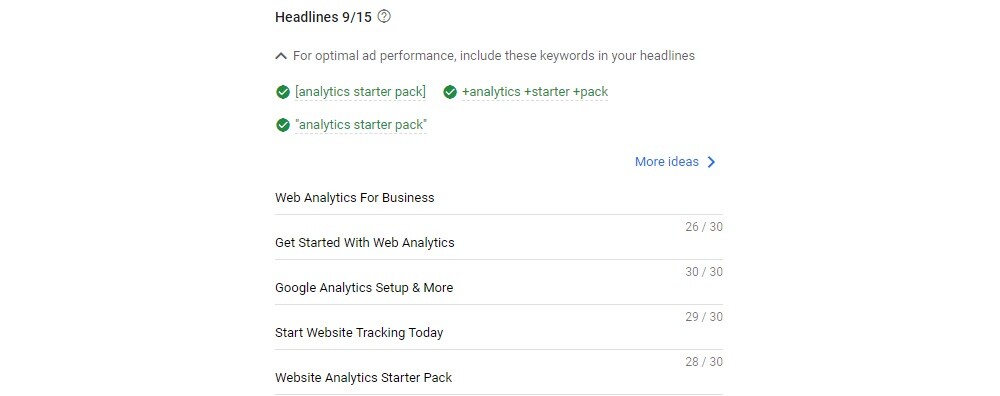If you have used Google Ads or Microsoft Advertising you may have heard of responsive search ads before. They are the current default ad type on many paid digital marketing platforms and understanding what they are and how they function is vital to effective digital advertising.
What is a responsive search ad?
With the recent announcement by Google that expanded text ads will be retiring in June 2022, do you know exactly what a responsive search ad is? Responsive search ads are the newest version of paid search ads online. These are the text ads that appear alongside search results when a search engine is used.

A typical text ad as it appears in Google search results.
When appearing to your audience, they will look very similar to the current generation of paid search ads, known as Expanded Text Ads. However, responsive search ads have significantly different underlying functionality and features. With responsive search ads, there are more options available for you to text and experiment before displaying them to potential customers.
- Multiple variations can be displayed with a single responsive search ad.
- Responsive ads can make use of machine learning and algorithms to display the most effective ads.
- The most relevant variations can be shown based on the search query used to trigger the ad.
Digital marketing is constantly evolving, so this announcement by Google comes as little surprise. It seems like only yesterday that expanded text ads were announced, replacing the now-deprecated “original” text ads.

Paid search ads have advanced considerably over the years.
Don’t panic about needing to upgrade all of your ads as fast as possible. You can keep using all of your existing ads in the meantime (and beyond the June 2022 date). We’ll explain what the benefits are of upgrading to responsive search ads for your digital marketing efforts.
The benefits of responsive search ads
There are a few key differences between responsive search ads and expanded text ads. The last time text ads had an upgrade, they were given a single extra headline and description. Responsive ads are a more significant upgrade, so we’ll go over the main changes.
Multiple Ad Variations
Responsive search ads are much more fluid compared to traditional search ads. With the ability to create up to 15 unique headlines, a long headline and 4 descriptions, a single responsive ad can contain a lot of information. Rather than display all of this information at once, ads will be displayed as combinations of headlines and descriptions, in the same style as expanded text ads. Because of this, a single responsive ad can run many different variations of itself to your audience.
For those of you who enjoy data like us, there are 43,680 different permutations of ads with 3 headlines and up to 2 descriptions.
You also have the ability to “pin” a specific headline and description to your ad to ensure they always appear. This may be a key phrase, or perhaps your brand name, while still testing variations of other headlines and descriptions. As you can imagine, this can save a lot of time and effort when building digital marketing ads, and giving you the ability to test your ad content to the limit.
Machine Learning
Unlike previous versions of text ads, responsive ads can take advantage of machine learning. Many of the major paid advertising platforms, such as Google, Microsoft and Facebook, all make use of algorithms and artificial intelligence to increase ad performance. As responsive ads can run multiple variations, the performance of different permutations of headlines and descriptions can be measured, to find out what works and what doesn’t.
They Adjust to Different Device Types
Responsive search ads can greatly improve mobile optimisation of your paid ads. As the majority of search results now appear on mobile devices, screen width, size and resolution can vary significantly.

On mobile devices, ads may appear differently due to screen size.
With the ability to adjust based on the screen size and available space, responsive ads can automatically make ad text clearer and easier to read. This can positively influence the click-through rate of your paid search ads. Existing expanded text ads may try to squeeze in text, or lower the font size, or even cut off some of the ad content. This may cause some mobile users to end up frustrated rather than clicking through to your website.
Trustworthy
The thought of having ads automatically deciding which headlines, descriptions, phrasing and context is best might make you feel uncomfortable. This is especially true if you’re checking your paid ads often, as using any degree of automation will sacrifice a bit of your control. However, responsive ads can be viewed as quite trustworthy. The algorithms and machine learning that takes place in the background is managed by the marketing network, such as the Google Network or Microsoft Advertising Networks.
It’s in the best interest of marketing platforms to constantly improve their own algorithms and machine learning capabilities.
Marketing platforms compete with each other every day for customers. Their success is tied to how well they can display ads for advertisers on their platform. Algorithms and machine learning are powerful tools for digital advertisers and are continuously developed and upgraded. They may not be perfect yet, but ad performance and accuracy will only get better over time using these techniques.
Reporting
Knowing exactly how your ad is performing is important. You certainly don’t want to waste your time and budget on ads that are not contributing to your online business. Responsive search ads still use many of the familiar metrics available with expanded text ads, such as:
- Clicks
- Impressions
- Click-Through Rate
- Cost Per Click
- Conversion Rate
However, responsive search ads also contain some additional performance information due to them using variations. By viewing the assets associated with the responsive ad (headlines and descriptions) you’ll be able to see how many impressions each individual asset has.

Headlines and descriptions can have their own set of metrics within a responsive search ad.
Furthermore, it’s also possible to view which combinations of headlines and descriptions are being displayed most frequently, and how often. You may find that one particular combination has a very high performance and gets shown more often than others.
One more reporting feature, that is unique to responsive ads, is ad strength. Expanded text ads don’t have this option. Ad strength relies less on traditional metrics such as clicks and impressions. Instead they make use of algorithms to help you create a well performing ad. Ad strength can vary from poor to excellent in Google Ads, and can be used as a guideline to write engaging ad content.

Ad strength is an estimate of how well your ad will perform when shown to potential customers.
How to create a responsive search ad (in Google Ads)
If you’re interested in trying to make your own responsive search ad, great! We’ll run you through the process using Google Ads. The process itself is very similar on other digital marketing platforms and there is a near identical experience if using Microsoft Advertising. To get started with creating your own responsive display ads, navigate to one of your ad groups and click on the blue plus sign, to create a new ad. You’ll be greeted with the following pop up.

Responsive search ads are now the default choice, in Google Ads.
Responsive search ads are now the default option for text ads. You may be wondering where the option for expanded text ads is, if they’re not due to be retired until June 2022. After selecting “Responsive search ad” from the menu, you’ll be brought to the ad creation screen. Here you can switch to expanded text ads, via a prompt at the top.

Expanded text ads are still available for creation.
To begin your responsive search ad, enter your Final URL. This will be your landing page on your website for the ad, so make sure it’s relevant to your ad content and campaign intentions.

Select the landing page for your responsive search ad. Remember that it should be relevant!
Now onto the main ad content. You have the option to create up to 15 headlines. 15 is not always necessary, but it’s good practice to use many so that the responsive ad has a chance to test more variations. Your headlines can appear in any order, so while they should follow the same theme, be sure to mix them up to test what headlines work best together. If you get stuck, there’s often suggestions provided based on your keywords and landing page content.

With up to 15 headlines, there’s a lot of possibilities in a single responsive ad.
Lastly, add your descriptions. These contain most of the ad text, allowing up to 90 characters each and should describe what service or product you’re offering and it’s features. Up to 4 of these can be added, and as any ad can show up to 2 at once, we recommend using all 4 descriptions in your responsive ad.

Choose up to 4 descriptions. Remember that up to 2 can appear within the same ad.
Finally, save your responsive search ad, and you’re all done! Compared to expanded text ads, they can sometimes take a little longer to be reviewed and accepted as eligible to be displayed, but this process doesn’t usually take very long.
Should you stop using expanded text ads right now?
It may seem that, with the looming demise of expanded text ads next year, you should stop using them right now. While this is an option, expanded text ads still have a number of benefits over responsive search ads, such as being able to test precise variations for performance.
Expanded text ads will still be supported all the way up until June 2022. Even beyond then, they’ll more than likely still be usable as paid search ads and perform well. While machine learning, algorithms and responsive all sound fantastic, they do sacrifice a little bit of control over your ads. Small changes can make big differences. If you do decide to upgrade all of your ads to responsive search ads, stay vigilant and check your ad performance often. This is something we recommend you do on a regular basis to make sure your digital marketing stays relevant and up to date.